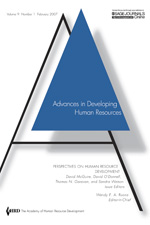A Good Living Versus A Good Life
How can HRD help ensure a meaningful and purposeful life for employees in the workplace? Neal Chalofsky and Liz Cavallaro, both of George Washington University explored this question in their study, “A Good Living Versus A Good Life: Meaning, Purpose and HRD,” forthcoming in Advances in Developing Human Resources and now available in the journal’s OnlineFirst section:
The Problem.
The expectation for meaningful work and work–life integration is firmly entrenched in the minds of the GenerationY/Millennial generations in the workplace. Yet, in updating the literature and rethinking the impact on Chalofsky’s (2003) construct for meaningful work, the question arose as to whether meaningful work can and should exist in a vacuum or should it be viewed as part of a meaningful life. If so, what are the implications for the construct and for human resource development (HRD). How far can and should HRD go to help ensure a meaningful and purposeful life for present and future generations in the workplace?
This article provides a sketch of the current research and thinking about meaningful work and a basis for the rest of the articles in this issue. The tightness of the “fit” between self and work can determine how meaningful one’s work is perceived. How work fits within a meaningful life, and how one’s life fits within the context of the organization, the community, the society, and the planet can shape a meaningful existence.
The Stakeholders.
The intended audience for this article includes HRD scholars, scholar-practitioners, consultants, and students interested in the construct of meaningful work, and the implications of reframing HRD around meaning and purpose.
Continue reading the paper online in in Advances in Developing Human Resources, and sign up for e-alerts so you don’t miss out on new articles like this one.














![Share Your Most Surprising Policy Citation for Chance to Win $500 [Closed] Share Your Most Surprising Policy Citation for Chance to Win $500 [Closed]](https://www.socialsciencespace.com/wp-content/themes/conferpress/images/default_thumbnail-new-border.jpg)

























































































